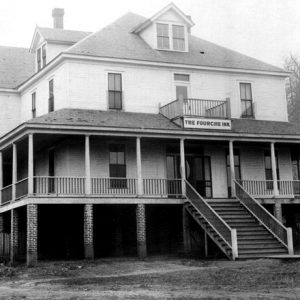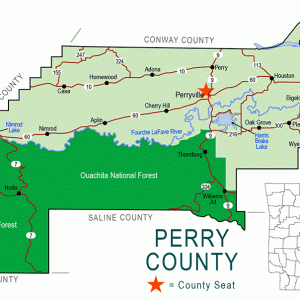calsfoundation@cals.org
Fourche (Perry County)
| Latitude and Longitude: | 34°59’38″N 092°37’16″W |
| Elevation: | 292 feet |
| Area: | 0.20 square miles (2020 Census) |
| Population: | 56 (2020 Census) |
| Incorporation Date: | December 2, 1906 |
Historical Population as per the U.S. Census:
|
1810 |
1820 |
1830 |
1840 |
1850 |
1860 |
1870 |
1880 |
1890 |
1900 |
| – | – | – | – | – | – | – | – | – | – |
|
1910 |
1920 |
1930 |
1940 |
1950 |
1960 |
1970 |
1980 |
1990 |
2000 |
| – |
164 |
94 |
88 |
51 |
48 |
46 |
51 |
55 |
59 |
|
2010 |
2020 |
||||||||
|
62 |
56 |
The town of Fourche (the name is pronounced to rhyme with “bush”) is located in northeastern Perry County on the banks of the Fourche La Fave River, for which it is named. Once a thriving lumber town, Fourche is now overshadowed by Bigelow (Perry County), its neighbor to the west.
The Fourche La Fave River was explored by a French settler, Peter La Fave, who gave his name to the river, “fourche” being the French word for “fork.” The first white settlers, who arrived after the Civil War, were German, including Gottlob Faisst, who owned a tomato cannery he named Central Arkansas Food Products Company. Faisst and his family also owned a wine saloon, skating rink, and pool hall, all located in the same building, which was used as a community center for the German settlers. Faisst’s most important company was the Bryant Lumber Company. The company, which employed many of the town’s citizens, was one of at least three such companies established in the area when the Choctaw, Oklahoma, and Gulf Railroad built a line into the area to transport harvested timber. The town of Fourche was incorporated in 1906.
When the timber industry flourished in the early years of the twentieth century, Fourche prospered, as did its neighbors Esau (later renamed Bigelow) and Graytown. Fourche had a train depot, a bank, and a cotton gin. A hotel, the Fourche Inn, was owned by Ben Kassle. It also had a stock yard; the Finkbeiner Meat Packing Company was founded in Fourche. A post office was established in Fourche in 1908, moved to Bigelow in 1912, reinstated in Fourche in 1916, and finally closed in 1933.
The competition between the towns reflected the competition between rival lumber firms. Construction of the Choctaw Line Railroad opened Perry County for harvesting of virgin timber. The Bryant Lumber Company, established in 1900, was owned and operated by the Faisst family. The Fourche River Lumber Company, established in 1902, had out-of-state ownership. The 20,000 acres belonging to the Bryant Lumber Company and the 40,000 acres owned by the Fourche River Lumber Company could only be reached through one right-of-way access, near the confluence of the Fourche La Fave and Arkansas rivers. By 1904, a slew of competing lawsuits had been filed between the two companies, charging one another with trespass, theft of lumber, damage of property, threats of violence, intimidation, and other unlawful activities. The Fourche River Lumber Company was accused of trying to drive a homesteader off his land, including the burning of his house in December 1904. Meanwhile, the Bryant Lumber Company was accused of setting fires and using dynamite to destroy railroad bridges in October 1904, April 1905, and June 1905, the third attack also damaging a railroad engine and, according to some sources, nearly killing the engineer and fireman. Compromises were negotiated (and allegedly broken) while both companies continued to harvest lumber from their property. In the end, the Fourche River Lumber Company, both better financed and better organized, won their court cases against the Bryant Lumber Company. The smaller company was permitted to continue operating, however, using the railroad of the Fourche River Company. This logging continued until the early 1920s, when most of the timber had been cut.
Lumber companies, in Fourche and elsewhere in Arkansas, also had some unsavory and sometimes criminal labor practices during this time. According to historian Nan Woodruff’s American Congo: The African American Freedom Struggle in the Delta, “Lumber companies often used convict labor or engaged in peonage. The Bryant Lumber Company of Fourche, Arkansas, recruited twelve unsuspecting Hungarian immigrants from New York City who spoke no English….When the immigrants arrived, the company seized their luggage and all of their clothes and forced them to live in a guarded boarding house run by an outside party. When people tried to run away, they were arrested.”
However, when this incident was brought to court in 1913, the company was acquitted of all charges. It was revealed that the ten (not twelve) laborers brought from New York had signed a contract that included provisions for them to work off the cost of their transportation to Arkansas. Their luggage had been held by the company bookkeeper, but they had been given access to the luggage for fresh clothing. Their board at the local hotel was deducted from their salary and paid by the company to the hotel. At no time was the hotel guarded by company agents. When the workers attempted to leave the area four days after their arrival, they were stopped by the Fourche town marshal in Little Rock (Pulaski County) and were returned to Fourche. Hearing the evidence, the jury deliberated for eight hours before acquitting Faisst and the Bryant Lumber Company.
The population of Fourche in the early twentieth century included a number of African Americans. Both churches established in Fourche—one Baptist and one Methodist—were attended by black laborers and their families. A school was also established near Fourche.
By the end of the 1920s, the lumber industry of Perry County was declining, and many workers were moving away to find jobs elsewhere. The Flood of 1927 also threatened the riverside town. Both churches had closed by the mid-1950s.
Although a city hall was built in 1975, the town of Fourche has continued to decline in population. As of the 2010 census, the town had only sixty-two residents, all of whom were white. The only significant landmark in Fourche is the Faisst cemetery on the south end of town.
For additional information:
Living the Times, 1776–1976: A Bicentennial Tribute to Perry County. Casa, AR: Perry County Extension Homemakers Council, 1989.
Perry County Historical & Genealogical Society. Perry County, Arkansas: Its Land & People. Marceline, MO: Walsworth Publishing Company, 2004.
Steven Teske
Butler Center for Arkansas Studies
 Fourche Inn
Fourche Inn  Perry County Map
Perry County Map 



My great-uncle was the camp physician at this mill. His name was Dr. Edwin Kubale.
He died in 1923.